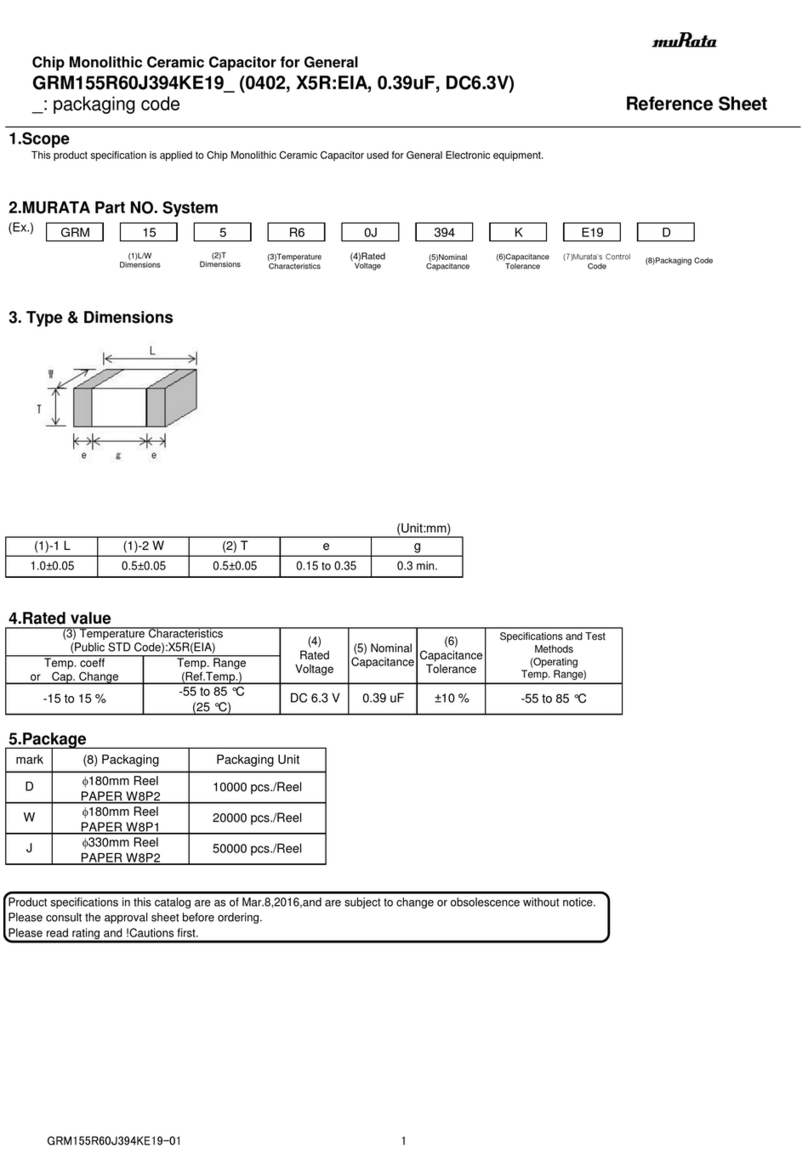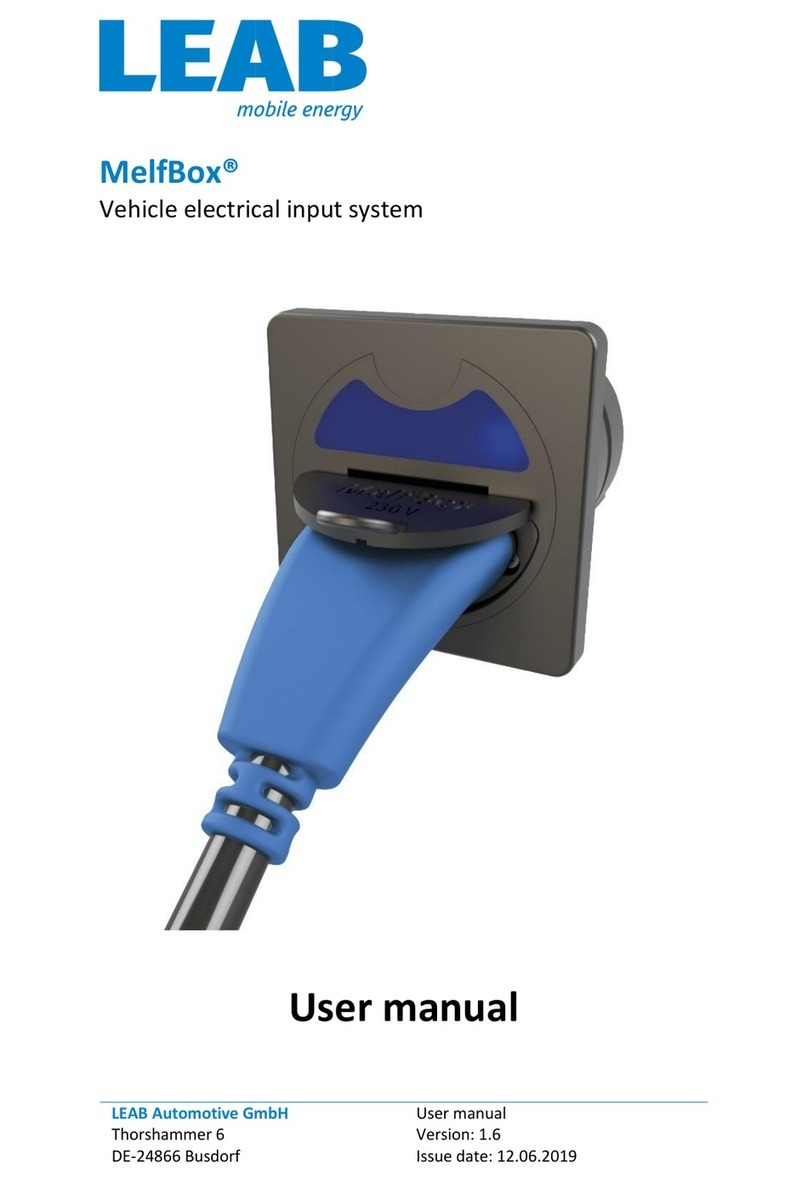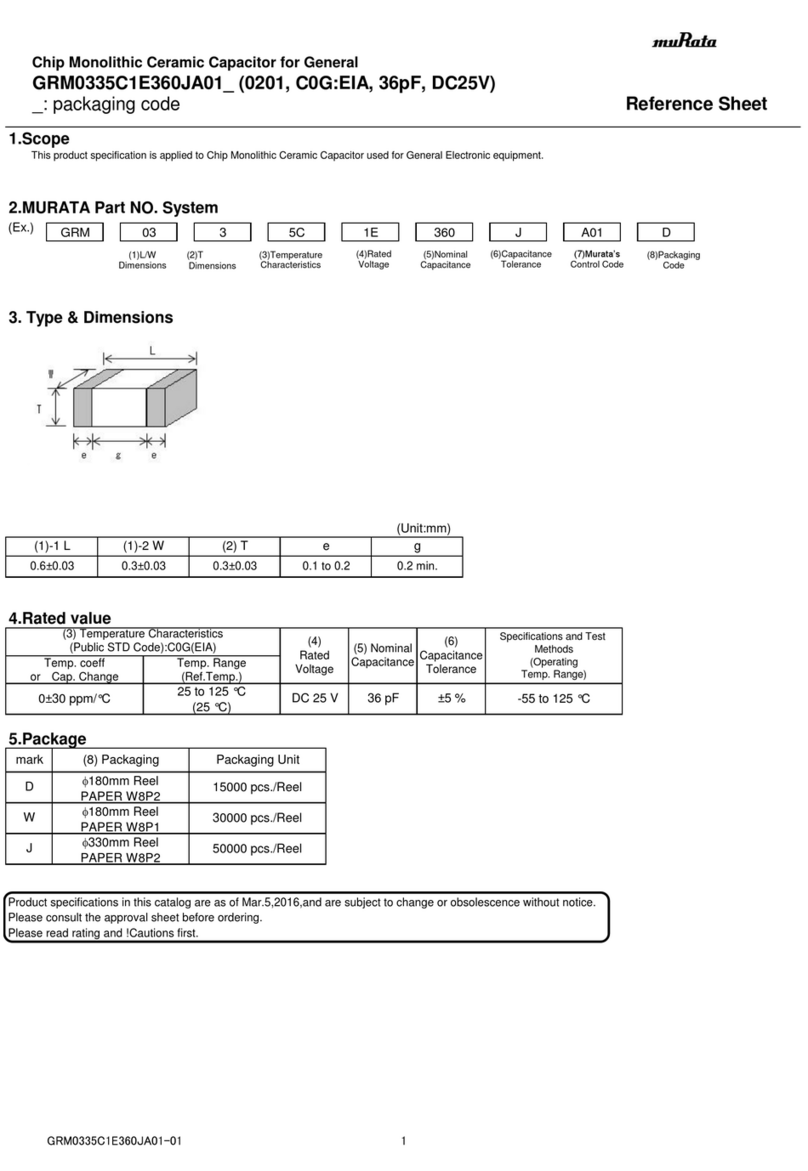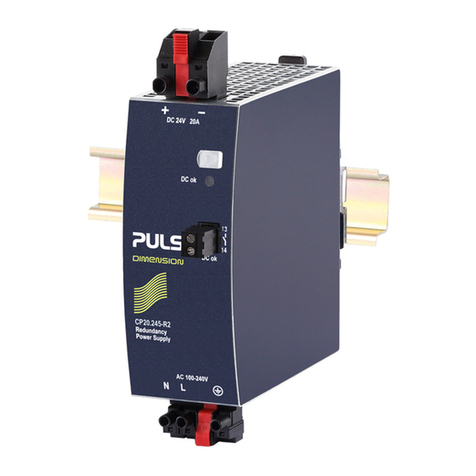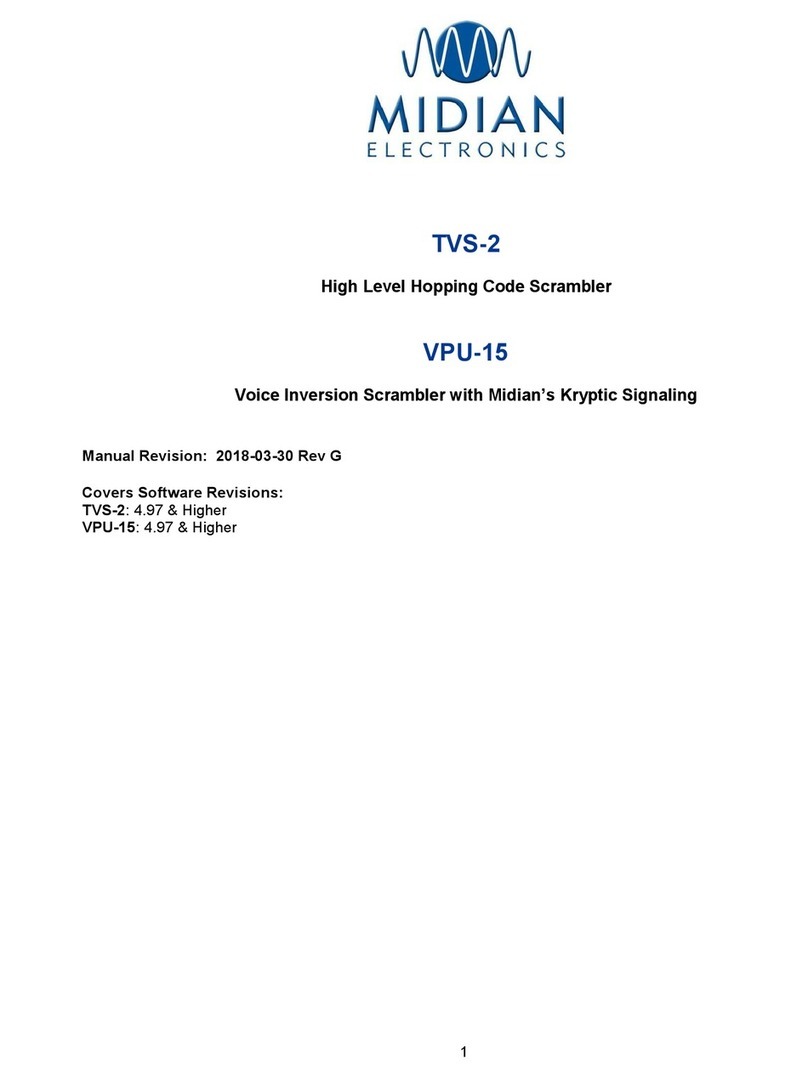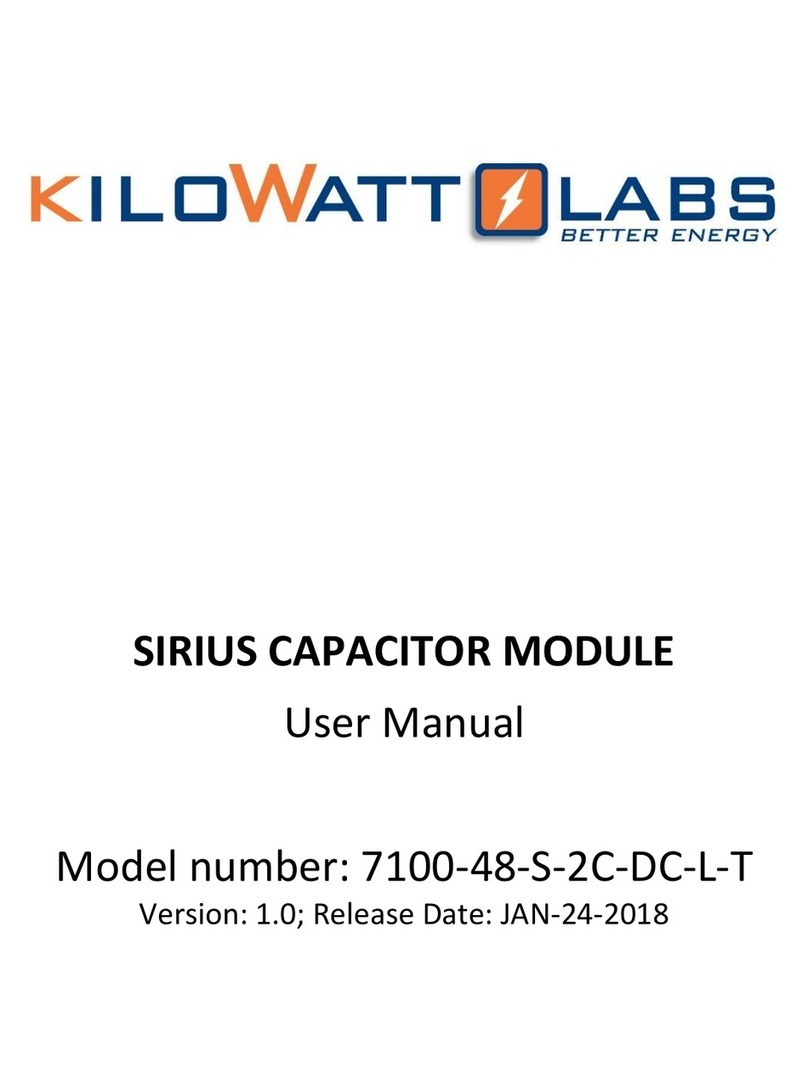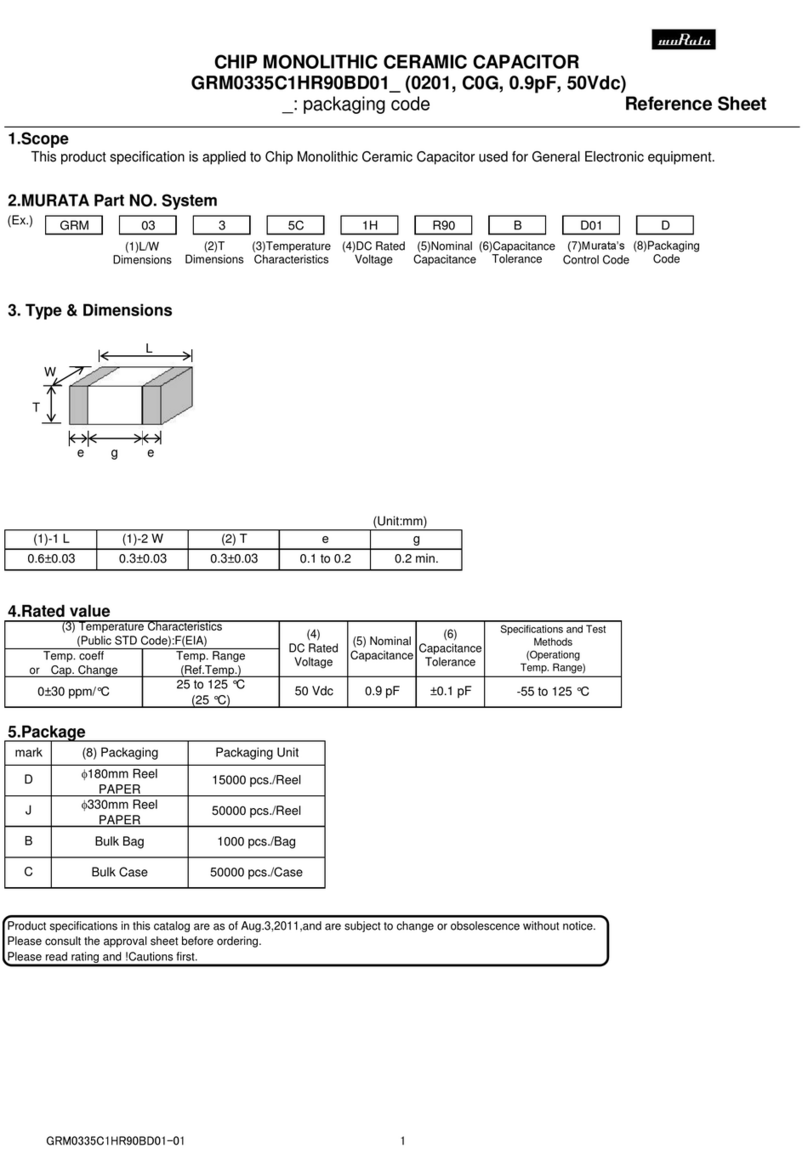Linear Technology LTC4364HDE-1 Quick setup guide

1
dc2027af
DEMO MANUAL DC2027A
Description
LTC4364HDE-1, 2
12V Surge Stopper
with Ideal Diode
Demonstration circuit 2027A showcases the LT C
®
4364
surge stopper with ideal diode in a 12V, 1A application.
DC inputs of up to 80V and transients to 250V are limited
to just 28.7V at the output. Sagging and reverse-polarity
inputs of up to –24V are isolated from the output by a
reverse-blocking MOSFET configured as an ideal diode.
Further, the output is protected against backfeeding. The
output may be driven –20V to +30V without circuit damage
or backfeeding into the input.
A4.7μF timer capacitor and robust forward MOSFET
permit the load to operate through ISO-7637-2 load dump
L, LT, LTC, LTM, Linear Technology and the Linear logo are registered trademarks of Linear
Technology Corporation. All other trademarks are the property of their respective owners.
performance summary
waveform5A.Sustainedovervoltageorovercurrent condi-
tions cause the LTC4364 to turn off after a timer delay.
The LTC4364-1 (DC2027A-A) latches off and is reset
by pulling SHDN low for at least 100μs. The LTC4364-2
(DC2027A-B) automatically retries after a three minute
cool down delay. Start-up and retry are inhibited in the
presence of an input overvoltage.
Design files for this circuit board are available at
http://www.linear.com/demo
PARAMETER CONDITIONS MIN TYP MAX UNITS
Input Voltage Limits Operating
DC Survival
1ms Transient
6.6
–24
12 27
80
250
V
V
V
Output Voltage Limits Regulation Voltage
DC Backfeed Protection
27.2
–20
28.7 30.3
30
V
V
Output Current Capability Operating
Current Limit
2.125
2.5
1
2.875
A
A
Specifications are at TA= 25°C
Quick start proceDure
DANGER! HIGH VOLTAGE TESTING SHOULD BE
PERFORMED BY QUALIFIED PERSONNEL ONLY.
As a safety precaution at least two people
should be present during high voltage testing.
Board Layout
DC2027A is a 2-layer board. There are planes for input,
output and ground; these are replicated on each layer. The
93mil input and output connection turrets are not swaged
and may be removed for attachment of up to 12 AWG wire.
Banana jacks facilitate bench testing. There are exposed
conductors on the bottom of the board, and any banana
plugs present will protrude through the bottom of the
board. The underlying surface should be nonconductive
and clear of any wire, solder and other conductive debris.
The input plane is designed to have at least 78mil (2mm)
clearance to adjacent conductors. This is adequate for
100VDC standoff andtransients to250V. Spikes andsurges
are withstood by RLED1, QLED1, ROV1, RUV1, R4, Q1 (if
present), D3, M1, RSNUB and CSNUB. These components
are chosen for wide pad spacing, pulse power capability
and voltage stand off, but ultimately limit the maximum
transient input voltage to ≈250V. The time spent above
80V is limited by the pulse power capability of R4.

2
dc2027af
DEMO MANUAL DC2027A
Quick start proceDure
Figure 1. Remove RVCC and Add Q1 to Withstand Prolonged Inputs of Up to 250V. R4 Is Increased to 270k
OPERATION
DC2027A has been designed for 12V operation with a load
of up to 1A. M1 limits surges, spikes and transients, such
as are commonly encountered in automotive applications.
For positive-going events, the output is regulated at 28.7V.
Spikes of up to 250V are permissible for 1ms, limited by
the pulse capability of R4. The load may continue operating
during positive transients, including load dump, without
interruption.
Reverse inputs of up to –24VDC are blocked from reaching
the load by M2. Beyond –24V, a 400W transient voltage
suppressor, D4, clamps the input. Consult the SMAJ24A
data sheet for specific information about peak current and
time duration for spikes exceeding –24V.
DC2027A-A is fitted with the LTC4364-1. This device
latches off after a sustained overcurrent or overvoltage
fault. Operation is resumed after cycling the supply, or
after pulsing SHDN low for at least 100μs.
DC2027A-B is fitted with the LTC4364-2, which also shuts
off the output in the presence of a sustained fault condi-
tion, but automatically retries after a cool-down delay of
180 seconds. The cool-down delay may be prematurely
interrupted by pulsing SHDN low for at least 100μs.
In both cases, retry is inhibited by the OV pin if the input
is higher than 16.8V, as is start-up.
While a maximum load current of 1A is permitted during
start-up and overvoltage conditions, current limit is set
to 2.5A. This higher current level is permissible during
normal (12V) operation. In short-circuit conditions where
VOUT = 0V, current limit folds back to 1.25A.
The output is protected against backfeeding over a range
of –20V to 30V. If the output is connected to a low imped-
ance source of less voltage than the input, M1 will likely
go into current limit and fault off. If the output is higher
than the input, M2 will block backfeeding. In the case that
the output is higher than the 28.7V regulation voltage, the
timer will run and M1 will fault off.
Optional Components
The pulse power limitations of R4 may be avoided by
adding Q1. Pads are located on the bottom of the board.
Remove RVCC (a0Ω jumper) and increase R4 to 270k
(see Figure 1). Remember that the board spacing is only
78mils, and that this is inadequate for creepage and clear-
ance at 250VDC.
Pads are included on the bottom of the board for optional
outputcapacitorsCOUT3and COUT4,in theevent additional
bypassing is desired.
Through-hole pads are included for adapting DC2027A to
an off-board power stage, as shown in Figure 2.
VCC
LTC4364
dc2027a F01
C1
100nF
100V
Q1
PZTA42
RVCC
REMOVED
D1
CMZ5945B
68V
D4
SMAJ24A
D3
ES1G
R4
270k
1206
INPUT

3
dc2027af
DEMO MANUAL DC2027A
Quick start proceDure
Figure 2. Connections to an Off-Board Power Stage. Remove M1, M2, RSNS, RSNUB
and RESR from Board. Keep Wires Short to Avoid Parasitic Oscillations in M1
Small Turrets
No connection to any of the small turrets is necessary
to make the board operate—the LTC4364 defaults to the
ON state.
SHDN is pulled high internally. If this turret is left open,
the board will turn on when power is applied. Short this
turret to ground to turn off the LTC4364.
F LT is an open-drain output which pulls low after a TMR
interval if there is a sustained input overvoltage, and does
so 94ms before the output shuts down. In overcurrent
there is a brief early warning delay, the exact time of which
depends on the severity of the overload. There is no pull-up
resistor for F LT ; it must be pulled up to an external logic
supply or to the output with an external resistor. F LT can
sink up to 2mA.
ENOUT is an open-drain output which goes high when
the output rises to within 700mV of the VCC pin. ENOUT
is latched and does not pull low again until the LTC4364
output drops below 2.2V. There is no pull-up resistor for
ENOUT; it must be pulled up to an external logic supply
or to the output with an external resistor. ENOUT can sink
up to 2mA.
TMR is made available so that its operation may be ex-
amined easily with an oscilloscope, by way of a 10MΩ
probe. Do not load or short this turret to ground as the
timer function will be defeated and an overload may de-
stroy M1. TMR normally sits at ground, and charges to
1.35V in a fault condition. This turret also finds use for
connecting different values of CTMR: simply remove the
existing CTMR and solder substitutes between the TMR
and GND turrets.
R5
10Ω
dc2027a F02
RESR
COUT
RSNUB
100Ω
HIGH CURRENT
OUTPUT
HIGH CURRENT
12V INPUT
CSNUB
10nF
M2 RSNS
M1

4
dc2027af
DEMO MANUAL DC2027A
HOW TO OPERATE DC2027A
DANGER! HIGH VOLTAGE TESTING SHOULD BE
PERFORMED BY QUALIFIED PERSONNEL ONLY.
As a safety precaution at least two people
should be present during high voltage testing.
To operate DC2027A, connect a 12V supply to the in-
put and a 1A load to the output, as shown in Figure 3.
The circuit will turn on automatically when power is
applied. Up to –24VDC may be applied to the input with-
out damage to DC2027A or the load. The output may be
backfed with –20V to 30V, without damage to DC2027A
or backfeeding of the input.
The preferred method of coupling a transient to the input
without backfeeding the 12V supply is to simply isolate
the sources with blocking diodes, as shown in Figure 4.
dc2027a F03
1A LOAD
(12Ω)
12V
SUPPLY
Figure 3. Basic Test Setup
Quick start proceDure

5
dc2027af
DEMO MANUAL DC2027A
dc2027a F04
1A LOAD
(12Ω)
INPUT FROM
SURGE GENERATOR
MUR460
MUR460
12V
SUPPLY
Figure 4. Simple Means of Coupling Surges, Transients and Spikes
Quick start proceDure

6
dc2027af
DEMO MANUAL DC2027A
parts List
ITEM QTY REFERENCE PART DESCRIPTION MANUFACTURER/PART NUMBER
Required Circuit Components
1 1 CHG CAP., X7R, 10nF, 100V, 20%, 0805 AVX, 08051C103MAT2A
2 2 COUT1, COUT2 CAP., X7S, 10µF, 50V, 20%, 1210 TDK, C3225X7S1H106M
3 0 COUT3, COUT4 CAP., X7S, 10µF, 50V, 10%, 1210 OPT
4 1 COV CAP., X7R, 1nF, 100V, 20%, 0805 AVX, 08051C102MAT2A
5 1 CSNUB CAP., X5R, 10nF, 500V, 20%, 1812 AVX, 18127C103MAT2A
6 1 CTMR CAP., X5R, 4.7µF, 10V, 10%, 0805 TDK, C2012X5R1A475K
7 2 C1, CUV CAP., X7R, 100nF, 100V, 20%, 0805 AVX, 08051C104MAT2A
8 2 DLED1, DLED4 LED, GREEN J-TYPE, LED-LN1351C-GREEN PANASONIC, LN1351C-TR
9 2 DLED2, DLED5 LED, RED J-TYPE, LED-LN1251C-RED PANASONIC, LN1251C-TR
10 2 D2, DLED3 DIODE, 300V, 250mA, SOD523 DIODES/ZETEX, BAS521-7
11 1 D1 DIODE, ZENER, 68V, 1.5W, SMA-DIODE CENTRAL SEMI., CMZ5945B
12 1 D3 DIODE, RECTIFIER, 400V, 1.0A, SMA-DIODE DIODES INC., ES1G-13-F
13 1 D4 DIODE, TVS, 24V, 400W, SMA-DIODE DIODES INC., SMAJ24A-13-F
14 2 D6, D7 DIODE, DDZ9702S, 15V, 200mW, SOD323 DIODES INC., DDZ9702S-7
15 6 E2, E3, E4, E5, E6, E8 TESTPOINT, TURRET, 0.094 MILL-MAX, 2501-2-00-80-00-00-07-0
16 4 E10, E11, E12, E14 TESTPOINT, TURRET, 0.064 MILL-MAX, 2308-2-00-80-00-00-07-0
17 4 J1, J2, J3, J4 BANANA JACK, NON-INSULATED KEYSTONE, 575-4
18 1 M1 MOSFET, N-CH, 250V, D2-PAK FAIRCHILD, FDB33N25TM
19 1 M2 MOSFET, N-CH, PWR 100V, 7.5A, SO8 FAIRCHILD, FDS3672
20 1 QLED1 TRANSISTOR, NPN, 300V, SOT223 FAIRCHILD, PZTA42
21 1 QLED2 TRANSISTOR, NPN, 40V, SOT-23 DIODES/ZETEX, MMBT3904-7-F
22 0 Q1 TRANSISTOR, PZTA42, NPN, 300V, SOT223 OPT
23 1 RESR RES., SENSE, 0.1, 1/8W, 5%, 0805 NIC, NCST10JR100HTRF
24 3 RUV1, ROV1, RLED1 RES., CHIP, 249k, 1/4W, 1%, 1206 NIC, NRC12F2493TRF
25 1 RLED2 RES., CHIP, 200, 1/8W, 5%, 0805 NIC, NRC10J201TRF
26 2 RLED3, RLED4 RES., CHIP, 3.3k, 1/4W, 5%, 1206 NIC, NRC12J332TRF
27 2 ROV2, R8 RES., CHIP, 21k, 1/8W, 1%, 0805 NIC, NRC10F2102TRF
28 1 RSNS RES., SENSE, 0.02, 1/4W, 5% 1206 NIC, NCST12JR020JTRF
29 1 RSNUB RES., CHIP, 100, 1/2W, 5%, 1210 NIC, NRCP25J101TRF
30 1 RUV2 RES., CHIP, 66.5k, 1/8W, 1%, 0805 NIC, NRC10F6652TRF
31 1 RVCC RES., CHIP, 0, 0805 NIC, NRC10Z0TRF
32 1 R4 RES., CHIP, 2.2k, 1/4W, 5%, 1206 NIC, NRCP12J222TRF
33 1 R5 RES., CHIP, 10, 1/8W, 5%, 0805 NIC, NRC10J100TRF
34 1 R7 RES., CHIP, 453k, 1/8W, 1%, 0805 NIC, NRC10F4533TRF
35 4 MH1, MH2, MH3, MH4 STANDOFF, NYLON 0.5" KEYSTONE, 8833 (SNAP-ON)
36 1 U1 I.C., LTC4364HDE-1, DC2027A-A LINEAR TECHNOLOGY, LTC4364HDE-1
37 1 U1 I.C., LTC4364HDE-2, DC2027A-B LINEAR TECHNOLOGY, LTC4364HDE-2

7
dc2027af
DEMO MANUAL DC2027A
Information furnished by Linear Technology Corporation is believed to be accurate and reliable.
However, no responsibility is assumed for its use. Linear Technology Corporation makes no representa-
tion that the interconnection of its circuits as described herein will not infringe on existing patent rights.
schematic Diagram

8
dc2027af
DEMO MANUAL DC2027A
Linear Technology Corporation
1630 McCarthy Blvd., Milpitas, CA 95035-7417
(408) 432-1900 ●FAX: (408) 434-0507 ●www.linear.com
LINEAR TECHNOLOGY CORPORATION 2013
LT 0313 • PRINTED IN USA
DEMONSTRATION BOARD IMPORTANT NOTICE
Linear Technology Corporation (LT C ) provides the enclosed product(s) under the following AS IS conditions:
This demonstration board (DEMO BOARD) kit being sold or provided by Linear Technology is intended for use for ENGINEERING DEVELOPMENT
OR EVALUATION PURPOSES ONLY and is not provided by LT C for commercial use. As such, the DEMO BOARD herein may not be complete
in terms of required design-, marketing-, and/or manufacturing-related protective considerations, including but not limited to product safety
measures typically found in finished commercial goods. As a prototype, this product does not fall within the scope of the European Union
directive on electromagnetic compatibility and therefore may or may not meet the technical requirements of the directive, or other regulations.
If this evaluation kit does not meet the specifications recited in the DEMO BOARD manual the kit may be returned within 30 days from the date
of delivery for a full refund. THE FOREGOING WARRANTY IS THE EXCLUSIVE WARRANTY MADE BY THE SELLER TO BUYER AND IS IN LIEU
OF ALL OTHER WARRANTIES, EXPRESSED, IMPLIED, OR STATUTORY, INCLUDING ANY WARRANTY OF MERCHANTABILITY OR FITNESS
FOR ANY PARTICULAR PURPOSE. EXCEPT TO THE EXTENT OF THIS INDEMNITY, NEITHER PARTY SHALL BE LIABLE TO THE OTHER FOR
ANY INDIRECT, SPECIAL, INCIDENTAL, OR CONSEQUENTIAL DAMAGES.
The user assumes all responsibility and liability for proper and safe handling of the goods. Further, the user releases LT C from all claims
arising from the handling or use of the goods. Due to the open construction of the product, it is the user’s responsibility to take any and all
appropriate precautions with regard to electrostatic discharge. Also be aware that the products herein may not be regulatory compliant or
agency certified (FCC, UL, CE, etc.).
No License is granted under any patent right or other intellectual property whatsoever. LT C assumes no liability for applications assistance,
customer product design, software performance, or infringement of patents or any other intellectual property rights of any kind.
LT C currently services a variety of customers for products around the world, and therefore this transaction is not exclusive.
Please read the DEMO BOARD manual prior to handling the product. Persons handling this product must have electronics training and
observe good laboratory practice standards. Common sense is encouraged.
This notice contains important safety information about temperatures and voltages. For further safety concerns, please contact a LT C applica-
tion engineer.
Mailing Address:
Linear Technology
1630 McCarthy Blvd.
Milpitas, CA 95035
Copyright © 2004, Linear Technology Corporation
This manual suits for next models
2
Table of contents
Other Linear Technology Industrial Electrical manuals
Popular Industrial Electrical manuals by other brands
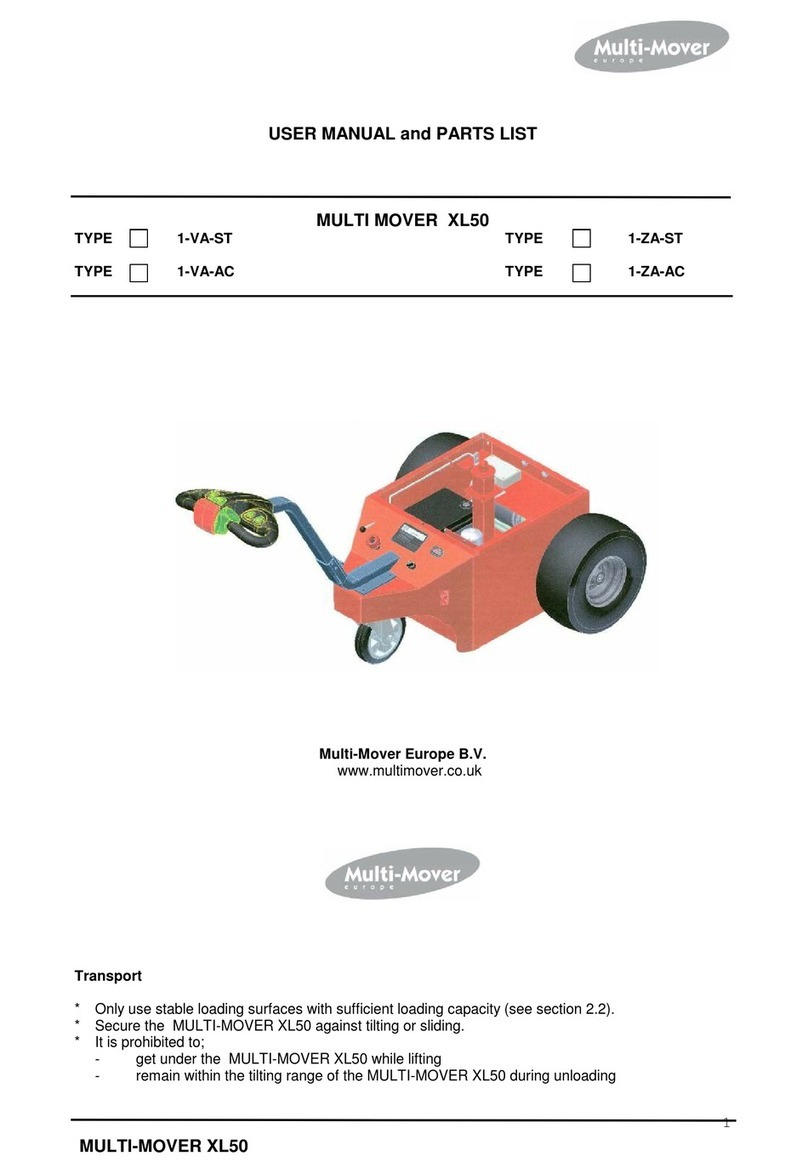
Multi-Mover
Multi-Mover XL50 User manual and parts list
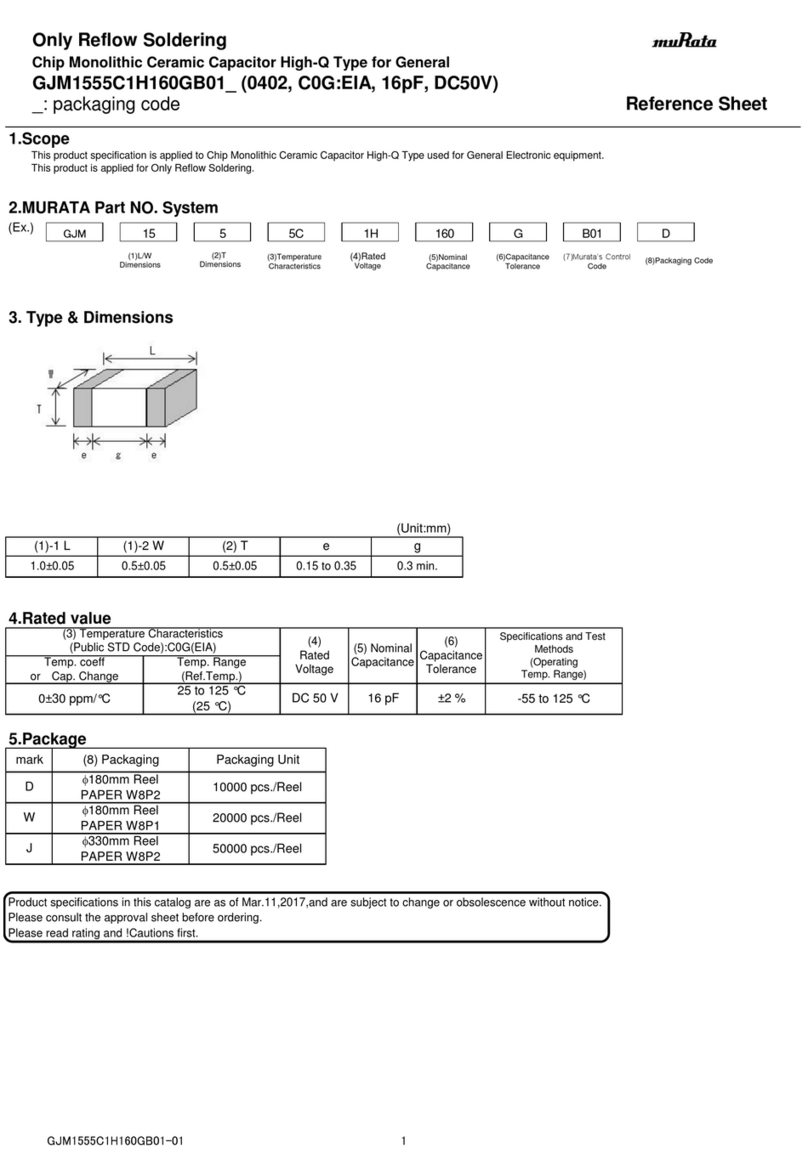
Murata
Murata GJM1555C1H160GB01 Series Reference sheet

Murata
Murata GRM033C80G273KE01 Series Reference sheet
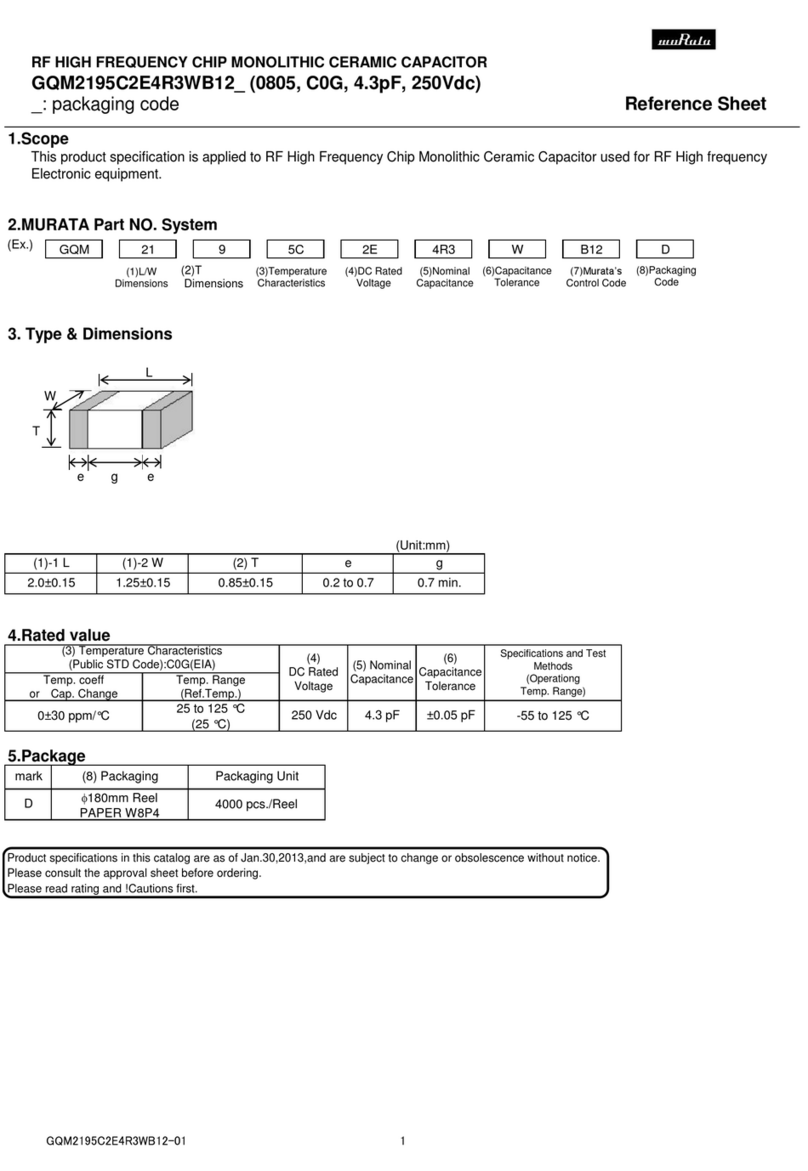
Murata
Murata GQM2195C2E4R3WB12 Series Reference sheet

Siemens
Siemens SITOP power DC-UPS Module 15 operating instructions

Murata
Murata GQM2195C2E2R0WB12 Series Reference sheet





